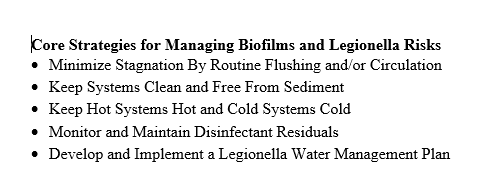COVID-19 “stay-at-home” orders have reduced water usage in facilities across the globe as buildings are shutdown or operated with low occupancy. The resulting stagnation in building water system equipment, piping, and fixtures can increase the risk for Legionella and other biofilm associated bacteria to grow, contribute to unsafe levels of lead and copper in potable water systems, and cause other serious problems.
This article was developed to provide building owners and operators with an overview of strategies that can be taken during shutdown and when buildings reopen to help address the Legionella risks associated with stagnation. However, due to the complexity of building water systems, the impact of operational and maintenance practices, and the universal nature of Legionella bacteria, no plan, program, or maintenance measures can guarantee the absence of Legionella or transmission of Legionnaires’ disease.
Core Risk Management Strategies
Building water systems can present significant Legionella risks, even when they’re fully occupied. Stagnant water increases these risks by causing conditions that favor the growth of biofilms, which are microscopic colonies of surface-attached bacteria directly linked to the growth of Legionella bacteria and other problems including corrosion and biofouling.
Without flow, the disinfectant added to the municipal water a building receives degrades as it sits in potable water systems, causing residuals to drop to ineffective levels. Similarly, the lack of flow in cooling tower systems, decorative fountains, and hot tubs prevents biocide or disinfectant additions from being effective. To compound the problem, stagnation may allow water temperatures to stabilize into the ideal range for Legionella growth (77°-108°F).
The U.S. Centers for Disease Control (CDC) recommends that building owners follow a recognized process, such as ASHRAE Standard 188, to assess Legionella risks and implement a site specific water management program (WMP). Where an active Legionella WMP is in place, the plan and program team should be referred to for guidance.
The WMP development process tailors maintenance and monitoring protocols to the Legionella risks associated with the building occupants and water systems. For example, the procedures appropriate for a commercial office building may not be adequate for a facility with high-risk occupants (assisted living, hospital, etc.). Likewise, the startup procedures for a building with an established flushing program during shutdown might be a lot different than the requirements where the building water systems were stagnant. Professional assistance from someone with experience relating to Legionella and WMPs is typically necessary to evaluate these factors so that appropriate measure can be taken.
With the rapid onset of COVID-19, many impacted buildings will not have a WMP or program team in place to provide direction. Regardless, building owners should understand the basic strategies that can be used to help address stagnation problems, and the need to develop a site-specific Legionella WMP when feasible.
Flush but Verify
It’s difficult to predict when facilities are going to reopen, so those in charge of maintaining buildings should be prepared to reopen on short notice, and routine flushing can be a key element of that ongoing maintenance. The idea that the system should be flushed regularly is not a new one; however, the verification element is really important. The goal of flushing is to reduce the need for more aggressive measures when a building is brought back online. The guiding principal is to replicate normal use of the system while not wasting water. Flushing offers additional benefits, such as keeping P-traps wet to prevent sewer gases from entering the building as well as minimizing the risk for elevated lead and copper levels.
Every flushing program should employ at least one of the detailed verification methods: Aesthetic water quality (color and odor) should always be included as part of the verification procedure.
Determining volume of the pipes and flushing two to three times the volume is helpful for deciding how long pipes should be flushed, but it doesn’t provide direct feedback to the water quality. Disinfectant residual monitoring may require the purchase of additional equipment but provides a good indicator that building water age is being appropriately managed. Temperature monitoring (depending on geography) may provide a good indicator that a flushing program is moving sufficient water.
Verify Your Disinfectant Levels
Within the distribution system, most states only require a “detectable” level of disinfectant. If your public water supplier (PWS) is using chlorine as its disinfectant, perform a free chlorine test to verify your disinfectant levels. If your PWS is using chloramines, do a total chlorine test or a total halogen test to verify levels.
In the short term, a facility manager doesn't have much control over what the PWS is delivering to a building. If necessary, a manager can reach out to the PWS and ask them to boost levels to the building’s portion of the distribution system, but oftentimes it may take days or weeks for this to actually occur, if it ever does.
One important statistic in terms of monitoring domestic water quality is the difference in disinfectant level from the building point of entry (where the water enters the building) to the points of use (i.e., sinks, showers, and toilets), which is commonly referred to as degradation. A facility’s goal should be less than 0.2 ppm degradation. If degradation is greater than that, it typically means one of two things: You have a dirty system, or the water age in the building is too great. Dirty systems could be the result of improper flushing early in the shutdown or years of fluctuating water use. Water age is the time it takes for the water to get from the city water main to the point of use (POU). Prolonged water age is often the result of oversized distribution piping or low/reduced occupancy.
Practical Flushing Advice
When flushing, don’t open too many fixtures at once — If too many valves are opened, water can be sucked back into the system. When the system restores pressure, this can lead to air pockets in the piping and water hammer.
Understand water distribution in the system before starting — When it’s time to flush, start at the service line to each building and then move toward the furthest points of use. Consider opening a sink at the end of the distribution system to ensure water is always moving in that direction. It’s important to move in this direction to ensure all the piping is flushed with fresh city water.
Start with the valves that have the widest openings — Save the diaphragm, float valve, and valves with the smallest openings for the end. Flushing may dislodge chip corrosion or scale. Starting with valves with wide openings will allow those large pieces of debris the best chance to be removed without needing to disassemble and unclog valves.
Potable Water Components
Before bringing facility back into operation, a facility manager should disinfect them in one of the following ways:
Faucets
Before bringing a facility back into operation, disinfect in one of the following ways:
- If performing a full system disinfection, run hot and cold water containing elevated levels of disinfectant through them;
- Perform extensive flushing with documented disinfectant residuals, temperature, and aesthetic quality;
- Disassemble, disinfect, and clean the internal components. If choosing this method, focus more on electronic faucets with the plastic internals; and
- Replace fixtures and piping from the wall to the POU.
Aerators & Flow Restrictors
Before bringing facility back into operation, disinfect in one of the following ways:
- If performing a full system disinfection, run hot and cold water containing elevated levels of disinfectant through them;
- Remove, disinfect, and clean the internal components. If heavily scaled or fouled, soaking in a weak acid may make removing deposits easier; and
- Replace aerators & flow restrictors.
Showerheads, Hoses, and Wands
Before bringing a facility back into operation, disinfect in one of the following ways:
- If performing a full system disinfection, run hot and cold water containing elevated levels of disinfectant through them;
- Remove, disinfect, and clean the internal components; and
- Replace entire showerhead or hoses and wand assembly.
Ice Machines
The following procedure should be followed for ice machines:
- Disinfect the inlet water supply line and install new filters prior to startup. Consider replacing piping from the wall to the ice machine;
- Clean, disinfect, and descale internal components; and
- Upon startup, discard the first one to three batches of ice before resuming ice making for human consumption.
Drink Dispensers
The following procedure should be followed for drink dispensers:
- Disinfect the inlet water supply line and install new filters prior to startup. Consider replacing piping from the wall to the fixture;
- Clean and disinfect water reservoirs; and
a. Prepare and discard the first several cups/pots of beverage. This should be the equivalent to 1 gallon or the volume of the reservoir, whichever is greater.
POU Water Filters
POU water filters are often installed before drinking fountains, refrigerators, soda machines, coffee filters, lab equipment, ice machines, and other equipment. In the majority of applications, POU filters are installed to remove taste and odor concerns associated with chlorine.
- If performing a full system disinfection, ensure compatibility of equipment with elevated levels of disinfectant. If compatible, run water containing elevated levels of disinfectant through associated piping to equipment; and
- If equipment is not compatible, disinfect associated piping and replace filter before startup.
Non-Potable Water Components
Before bringing facility back into operation and during downtime, take the following into consideration:
Cooling Towers, Fluid Coolers, and Evaporative Condensers
- Where possible, keep HVAC and process cooling tower systems operational. Do not discontinue water treatment and other maintenance measures. Leaving cooling tower systems filled with stagnant water can result in severe corrosion, biofouling problems, and contribute to the transmission of Legionnaires’ disease.
- Specific water treatment protocols may be required when cooling tower systems operate under low-load conditions. This includes circulating biocide treated water through any off-line or load cycled cooling towers, chillers, heat exchangers, and condenser water piping at least twice weekly.
- If a cooling tower system cannot be operated during an extended shutdown, it is recommended that all associated cooling towers, chillers, heat exchangers, and piping be completely drained. Where draining is not possible, consult your water treatment service provider to discuss alternate measures and specific cleaning and disinfection requirements prior to startup.
- Offline cooling tower systems should be cleaned and disinfected using an established protocol prior to returning to service. If cooling towers cannot be drained and physically cleaned prior to startup, online cleaning and disinfection processes should be considered.
Decorative Fountains
- Drain decorative fountains completely unless approved treatment and monitoring protocols are maintained; and
- All indoor and outdoor decorative fountains and man-made aesthetic fountains, water walls, cascades, etc., not in operation for three or more days must be drained, and all components cleaned and disinfected before startup.
Swimming Pools, Hot Tubs, and Whirlpool Spas
- All swimming pools, hot tubs, and whirlpool spas must be operated and maintained in accordance with manufacturer’s recommendations, state and local licensure and health permitting processes, and the CDC Model Aquatic Health Code;
- If one of these devices will be out of service for greater than three days, it should be completely drained unless approved treatment and monitoring protocols are maintained; and
- All systems should be properly cleaned and disinfected prior to placing back into use.
Misters, Atomizers, and Humidifiers
- All misters, atomizers, and cold-water humidifiers must be cleaned, disinfected, and have their filters changed (where installed) before being placed back into service.







